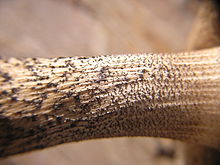
The Boletales are an order of Agaricomycetes containing over 1300 species with a diverse array of fruiting body types. The boletes are the best known members of this group, and until recently, the Boletales were thought to only contain boletes. The Boletales are now known to contain distinct groups of agarics, puffballs, and other fruiting-body types.

The Boletaceae are a family of mushroom-forming fungi, primarily characterised by small pores on the spore-bearing hymenial surface, instead of gills as are found in most agarics. Nearly as widely distributed as the agarics, the family is renowned for hosting some prime edible species highly sought after by mushroom hunters worldwide, such as the cep or king bolete . A number of rare or threatened species are also present in the family, that have become the focus of increasing conservation concerns. As a whole, the typical members of the family are commonly known as boletes.

Suillus is a genus of basidiomycete fungi in the family Suillaceae and order Boletales. Species in the genus are associated with trees in the pine family (Pinaceae), and are mostly distributed in temperate locations in the Northern Hemisphere, although some species have been introduced to the Southern Hemisphere.
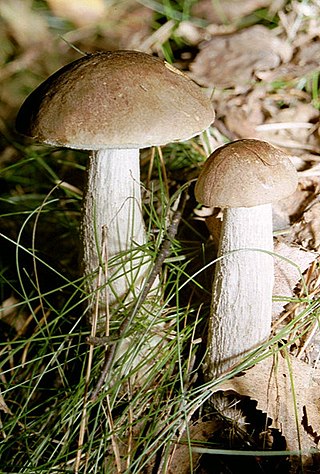
Leccinum scabrum, commonly known as the rough-stemmed bolete, scaber stalk, and birch bolete, is an edible mushroom in the family Boletaceae, and was formerly classified as Boletus scaber. The birch bolete is widespread in Europe, in the Himalayas in Asia, and elsewhere in the Northern Hemisphere, occurring only in mycorrhizal association with birch trees. It fruits from June to October. This mushroom is also becoming increasingly common in Australia and New Zealand where it is likely introduced.

Boletus is a genus of mushroom-producing fungi, comprising over 100 species. The genus Boletus was originally broadly defined and described by Carl Linnaeus in 1753, essentially containing all fungi with hymenial pores instead of gills. Since then, other genera have been defined gradually, such as Tylopilus by Petter Adolf Karsten in 1881, and old names such as Leccinum have been resurrected or redefined. Some mushrooms listed in older books as members of the genus have now been placed in separate genera. These include such as Boletus scaber, now Leccinum scabrum, Tylopilus felleus, Chalciporus piperatus and Suillus luteus. Most boletes have been found to be ectomycorrhizal fungi, which means that they form a mutualistic relationship with the roots system of certain kinds of plants. More recently, Boletus has been found to be massively polyphyletic, with only a small percentage of the over 300 species that have been assigned to Boletus actually belonging there and necessitating the description and resurrection of many more genera.

Paxillus involutus, also known as the brown roll-rim or the common roll-rim, is a basidiomycete fungus that is widely distributed across the Northern Hemisphere. It has been inadvertently introduced to Australia, New Zealand, South Africa, and South America, probably transported in soil with European trees. Various shades of brown in colour, the fruit body grows up to 6 cm high and has a funnel-shaped cap up to 12 cm wide with a distinctive inrolled rim and decurrent gills that may be pore-like close to the stipe. Although it has gills, it is more closely related to the pored boletes than to typical gilled mushrooms. It was first described by Pierre Bulliard in 1785, and was given its current binomial name by Elias Magnus Fries in 1838. Genetic testing suggests that Paxillus involutus may be a species complex rather than a single species.
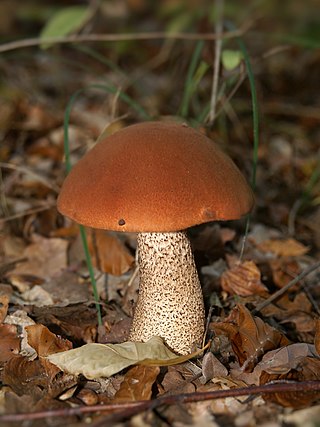
Leccinum aurantiacum is a species of fungus in the genus Leccinum found in forests of Eurasia and North America. It has a large, characteristically red-capped fruiting body. In North America, it is sometimes referred to by the common name red-capped scaber stalk. Some uncertainties exist regarding the taxonomic classification of this species in Europe and North America. It is considered edible, but must be cooked thoroughly.

Xerocomus subtomentosus, commonly known as suede bolete, brown and yellow bolete , boring brown bolete or yellow-cracked bolete, is a species of bolete fungus in the family Boletaceae. The fungus was initially described by Carl Linnaeus in 1753 and known for many years as Boletus subtomentosus. It is edible, though not as highly regarded as other bolete mushrooms.

Chalciporus is a genus of fungi in the family Boletaceae. There are approximately 25 species in the genus.

Leccinum manzanitae is an edible species of bolete fungus in the family Boletaceae. Described as new to science in 1971, it is commonly known as the manzanita bolete for its usual mycorrhizal association with manzanita trees. Its fruit bodies (mushrooms) have sticky reddish to brown caps up to 20 cm (8 in), and its stipes are up to 16 cm (6.3 in) long and 3.5 cm (1.4 in) thick. They have a whitish background color punctuated with small black scales known as scabers. Found only in the Pacific Northwest region of the United States and Canada, it is the most common Leccinum species in California. The mushroom is edible, although opinions vary as to its quality. L. manzanitae can be usually distinguished from other similar bolete mushrooms by its large size, reddish cap, dark scabers on a whitish stipe, and association with manzanita and madrone.
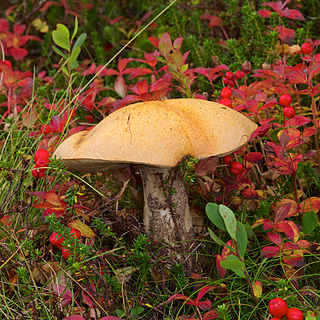
Leccinum versipelle, also known as Boletus testaceoscaber, dark-stalked bolete, or orange birch bolete, is a common species of mushroom that may be edible when given the right preparation. It is found below birches from July through to November, and turns black when cooked.

Harrya chromapes, commonly known as the yellowfoot bolete or the chrome-footed bolete, is a species of bolete fungus in the family Boletaceae. The bolete is found in eastern North America, Costa Rica, and eastern Asia, where it grows on the ground, in a mycorrhizal association with deciduous and coniferous trees. Fruit bodies have smooth, rose-pink caps that are initially convex before flattening out. The pores on the cap undersurface are white, aging to a pale pink as the spores mature. The thick stipe has fine pink or reddish dots (scabers), and is white to pinkish but with a bright yellow base. The mushrooms are edible but are popular with insects, and so they are often infested with maggots.

Butyriboletus is a genus of fungi in the family Boletaceae. The genus was circumscribed in 2014 by mycologists David Arora and Jonathan L. Frank to accommodate "butter bolete" species that were shown by molecular analysis to be phylogenetically distinct from Boletus. Butyriboletus contains 24 ectomycorrhizal species found in Asia, Europe, North America and north Africa.

Leccinum cyaneobasileucum is a species of bolete fungus in the family Boletaceae. Originally found growing under silver birch, it was described as new to science in 1991. The fungus produces fruit bodies with caps measuring 5–15 cm (2–6 in) wide that range in colour from hazel, to reddish-yellow, to walnut brown. The white to grey stipe measures 7–20 cm (3–8 in) long by 0.8–2 cm (0.3–0.8 in) thick and is covered with brownish scales. In deposit the spores are walnut brown; microscopically, they are somewhat spindle shaped and measure 14–18 by 5–6 μm. L. cyaneobasileucum grows under birch, usually in moss. The mushroom is edible but not particularly tasty.
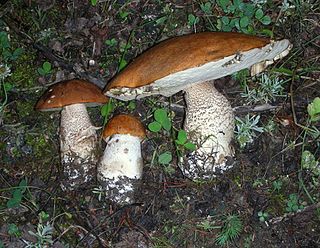
Leccinum insigne, commonly known as the aspen bolete or the aspen scaber stalk, is a species of bolete fungus in the family Boletaceae. Described as new to science in 1966, it is found in North America, where its range extends from eastern Canada south to New Jersey and west to the northern Rocky Mountains. It is a good edible mushroom, but there have been documented cases of adverse reactions; these range from headaches to gastrointestinal distress, which may or may not be attributed to food sensitivities alone. The specific epithet insigne means "distinctive or outstanding".

Leccinum holopus, commonly known as the white birch bolete, white bog bolete, or ghost bolete, is a species of bolete fungus in the family Boletaceae found in northern Asia, Europe, and northeastern North America. It associates with birch trees and is typically found in boggy or swampy areas, often growing among sphagnum moss.
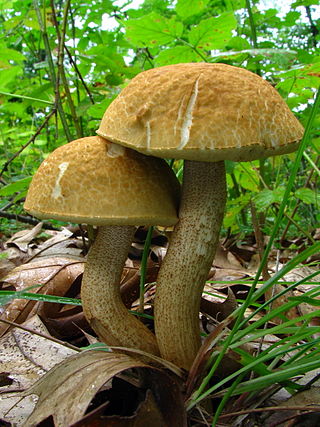
Leccinellum rugosiceps, commonly known as the wrinkled Leccinum, is a species of bolete fungus. It is found in Asia, North America, Central America, and South America, where it grows in an ectomycorrhizal association with oak. Fruitbodies have convex, yellowish caps up to 15 cm (5.9 in) in diameter. In age, the cap surface becomes wrinkled, often revealing white cracks. The stipe is up to 10 cm (3.9 in) long and 3 cm (1.2 in) wide, with brown scabers on an underlying yellowish surface. It has firm flesh that stains initially pinkish to reddish and then to grayish or blackish when injured. The pore surface on the cap underside is yellowish. Fruitbodies are edible, although opinions vary as to their desirability.

Sutorius eximius, commonly known as the lilac-brown bolete, is a species of fungus in the family Boletaceae. This bolete produces fruit bodies that are dark purple to chocolate brown in color with a smooth cap, a finely scaly stipe, and a reddish-brown spore print. The tiny pores on the cap underside are chocolate to violet brown. It is widely distributed, having been recorded on North America, South America, and Asia, where it grows in a mycorrhizal relationship with both coniferous and deciduous trees.
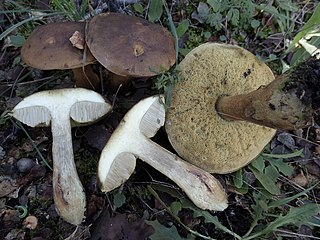
Leccinellum lepidum is a species of bolete in the family Boletaceae. Originally described as Boletus lepidus in 1965, the fungus has gone through controversial taxonomic treatments over the years and was subsequently transferred to genus Krombholziella in 1985, to genus Leccinum in 1990, and to genus Leccinellum in 2003. It is the sister-species of Leccinellum corsicum, with which it had been erroneously synonymised by some authors in the past.

